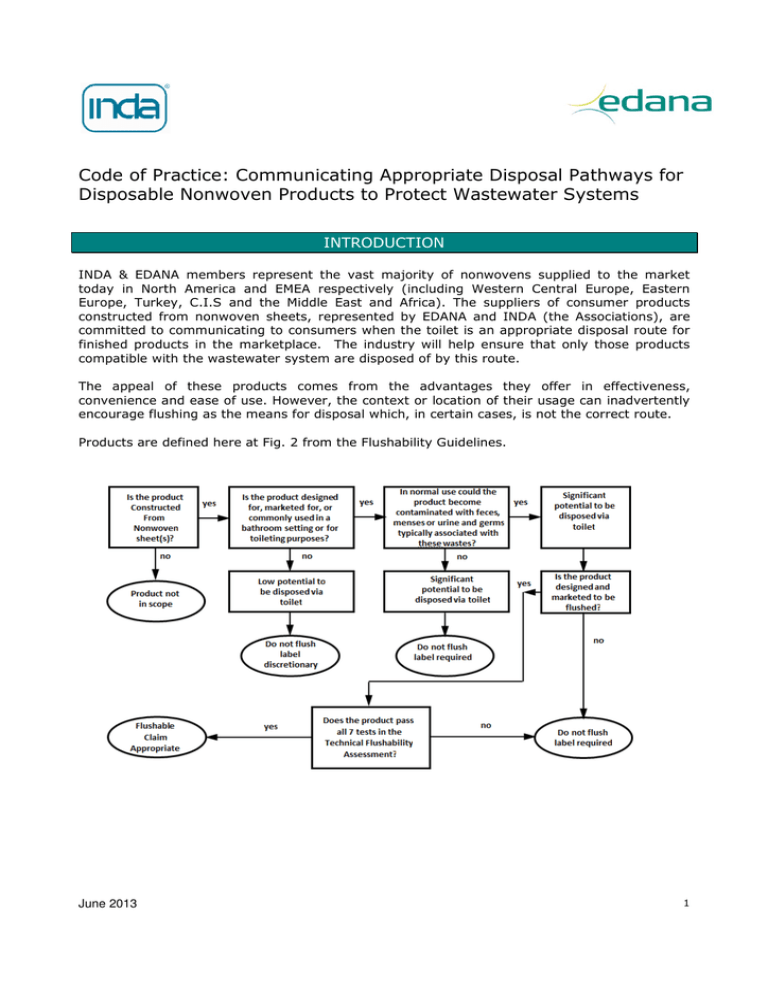Code of Practice: Communicating Appropriate Disposal Pathways for
advertisement

Code of Practice: Communicating Appropriate Disposal Pathways for Disposable Nonwoven Products to Protect Wastewater Systems INTRODUCTION INDA & EDANA members represent the vast majority of nonwovens supplied to the market today in North America and EMEA respectively (including Western Central Europe, Eastern Europe, Turkey, C.I.S and the Middle East and Africa). The suppliers of consumer products constructed from nonwoven sheets, represented by EDANA and INDA (the Associations), are committed to communicating to consumers when the toilet is an appropriate disposal route for finished products in the marketplace. The industry will help ensure that only those products compatible with the wastewater system are disposed of by this route. The appeal of these products comes from the advantages they offer in effectiveness, convenience and ease of use. However, the context or location of their usage can inadvertently encourage flushing as the means for disposal which, in certain cases, is not the correct route. Products are defined here at Fig. 2 from the Flushability Guidelines. June 2013 1 This Code of Practice outlines the commitments of the Associations and their member companies to: Use the Guidelines for Assessing the Flushability of Disposable Nonwoven Products1 for evaluating flushability of products prior to making a flushable claim; Only identify products as flushable when they meet all criteria contained in the above guideline; Clearly label all products with the ‘Do Not Flush’ logo whenever they are not designed to be flushed or fail the Flushability assessment1; Prominently and clearly display on these non-flushable products the recommended symbol, indicating that they should be disposed of via the solid waste system and not flushed into the wastewater system; Communicate appropriate disposal information for such products in relevant print literature and other communications channels (i.e. websites); For flushable products, clearly provide on the packaging explicit use and flushing instructions; Encourage companies who are not members of the Associations to comply with this Code of Practice; Encourage retailers to subscribe to this Code of Practice, particularly when sourcing private label products, and where possible reinforce proper disposal practices with their customers; and Where appropriate, support work at national and local levels to increase public awareness of proper disposal practices. PRODUCT DISPOSAL There are two primary disposal routes for disposable nonwoven products; via solid waste (trash or rubbish bin) and wastewater (toilet). Only products which have been assessed as flushable according to the definition of flushability and the assessment approach outlined in the Guidelines for Assessing the Flushability of Disposable Nonwoven Products1 should be disposed via the toilet. All other products should be disposed of via solid waste. The Definition of Flushability1 For a product to be deemed flushable there must be evidence indicating that it: Clears toilets and properly maintained drainage pipe systems when the suppliers recommended usage instructions are correctly followed; Passes through wastewater conveyance systems and is compatible with wastewater treatment, reuse and disposal systems without causing system blockage, clogging or other operational problems; and Is unrecognizable in effluent leaving onsite and municipal wastewater treatment systems and in digested sludge from wastewater treatment plants that are applied to soil. 1 For information on how to obtain a copy of the Guidance Document or the print-quality logos, visit http://www.edana.org/industry-initiatives/flushability or www.inda.org/issues-advocacy/flushability June 2013 2 ON-PACK CONSUMER INFORMATION The packaging of all finished products which have high potential to be discarded via the toilet must clearly inform consumers whether or not the products are appropriate for disposal via the wastewater system. Packaging for non-flushable products must clearly indicate that the product should not be disposed of via the toilet and display the ‘Do Not Flush’ (DNF) logo. Where space permits the additional use of the ‘Dispose via the Solid Waste Stream’ (‘Tidy Man’) logo to confirm disposal in solid waste is encouraged, where used, it is recommended to be same size as the DNF logo. Diameter ‘Do Not Flush’ logo ‘Tidy Man’ logo Location: The symbol(s) must be prominent, clearly visible and legible on primary/secondary consumer packaging. The logo should not be obscured by packaging seals. Color: Logo artwork should be dark on white background. Size: Diameter ≥1.1cm (0.45”) for Primary packaging.2 Diameter ≥2.5cm (1”) for Secondary consumer packaging e.g. On shelf club packs, display case, or bundles. Wording: Use of instructions with the DNF logo is optional. Any on-pack instruction for product disposal needs to be clear and explicit. Timing: By January 1, 2015 any existing non-flushable products are to be assessed and labeling updated. Thereafter, all new non-flushable products are expected to follow the Guidelines relating to this Code of Practice. 2 Exclusions: • Regulated products need to comply with size/placement requirements given by any relevant regulation or legislation. • Small packs: Diameter ≥0.635cm (0.25”) as space allows. June 2013 3 RAISING PUBLIC AWARENESS OF RESPONSIBLE DISPOSAL PRACTICES Responsible consumer behaviour is a key aspect in preventing non-flushable products from entering wastewater systems. The improper disposal of such products is one part of a much broader problem. The Associations and their member companies will consider opportunities to support governments, municipalities and wastewater authorities in implementing awareness-raising activities designed to increase understanding of the appropriate disposal routes for flushable and non-flushable wipes. PROMOTION OF THIS CODE OF PRACTICE Although voluntary, the Associations will promote this Code of Practice to its membership and will encourage member companies to operate within the spirit of the Code. The Associations will also seek to ensure that non-member companies are made aware of the Code and are encouraged to comply with it. June 2013 4


